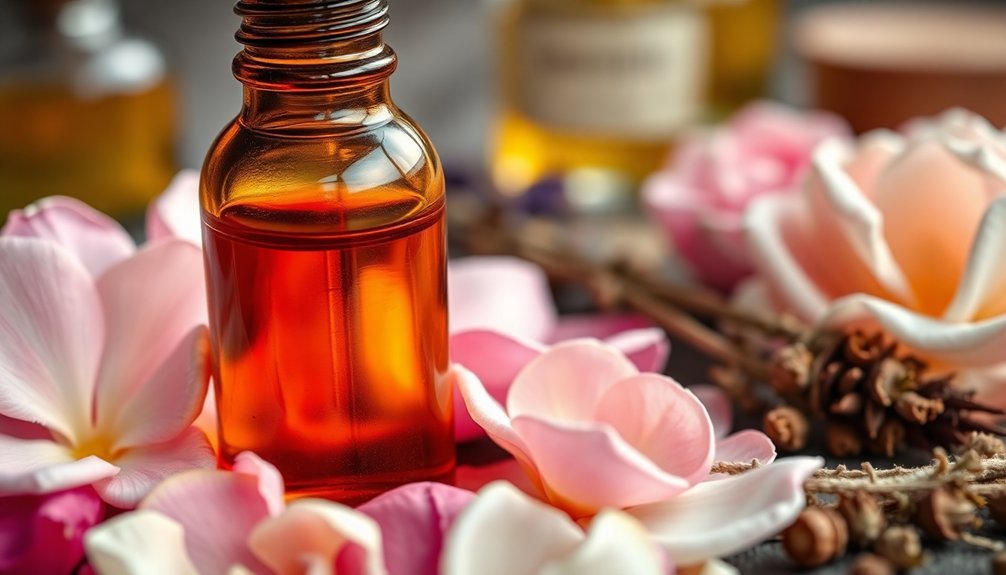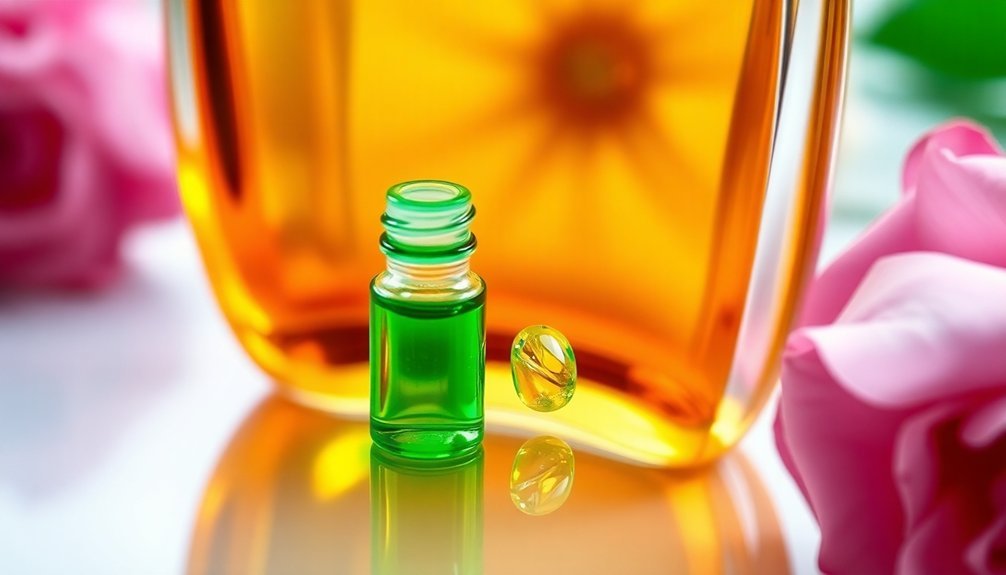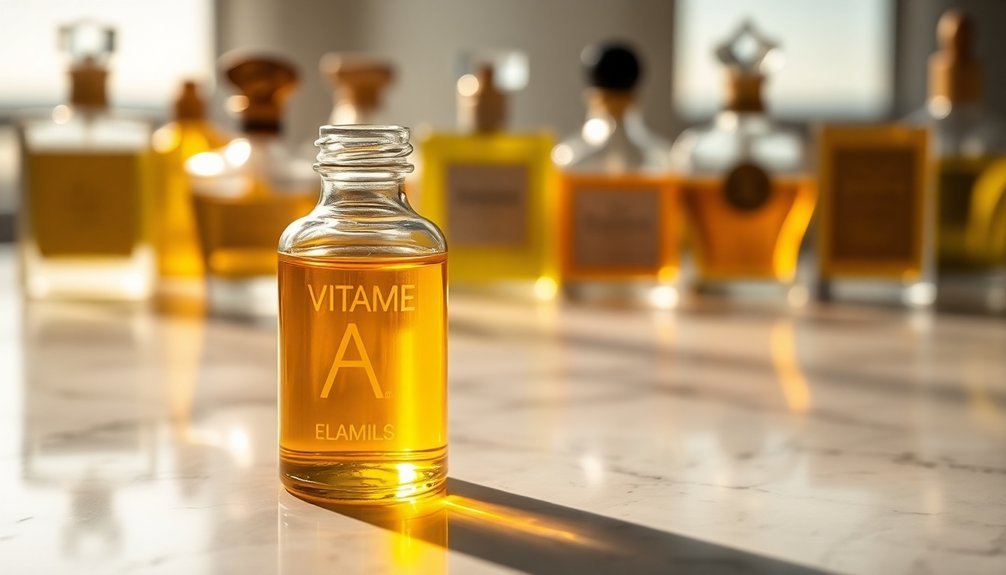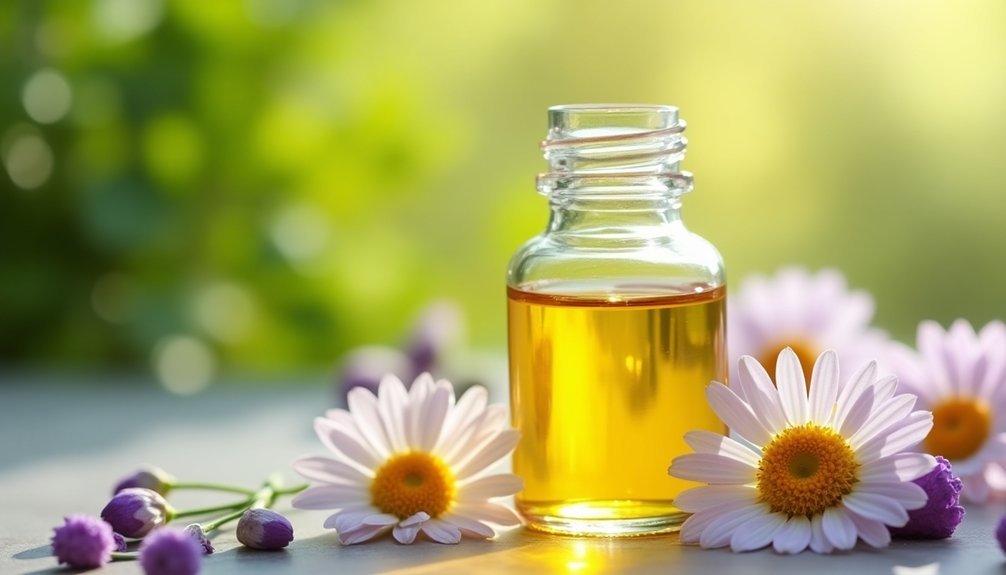Vitamin E isn't your complete perfume preservation solution, but it's a powerful antioxidant that helps protect your fragrances from oxidation when used correctly. You'll want to add 0.1-1% alpha tocopherol to shield your essential oils and perfumes from breaking down. While it won't prevent bacterial growth, it effectively neutralizes free radicals and maintains your fragrance's intended character. Understanding its proper use alongside other preservation methods will maximize your perfume's longevity and stability.
Understanding Vitamin E's Role in Perfume Making

While many people think of vitamin E as a preservative in perfumes, it actually serves as an antioxidant rather than a true preservative.
You'll find that true preservatives must prevent microbial growth, according to European Regulation n°1223/2009, which vitamin E doesn't do.
What vitamin E does offer your perfume formulation is protection against oxidation. Alpha tocopherol is especially effective for this purpose, as it's the only form that provides significant protective benefits.
When you're working with essential oils and pure undenatured ethanol, you'll want to add vitamin E at concentrations between 0.1-1% to protect these ingredients from degrading due to light, heat, or moisture exposure.
However, you'll need to be careful not to exceed these amounts, as too much vitamin E can actually harm your formulation by becoming a pro-oxidant.
The Science Behind Vitamin E as an Antioxidant
The remarkable chemistry of vitamin E makes it a powerful antioxidant in perfume formulations. When your perfume is exposed to oxygen and UV rays, vitamin E steps in to neutralize free radicals by donating electrons, effectively stopping oxidation in its tracks.
It's particularly effective at protecting the fatty components in your fragrance from breaking down. You'll find vitamin E working tirelessly in your perfume's oil-based ingredients, where it prevents lipid peroxidation that could otherwise alter your fragrance's scent and quality. The recommended safety limit of 1000 mg daily ensures that even concentrated perfume formulations remain well within acceptable ranges.
While it won't fight bacteria in your perfume, it excels at stabilizing natural ingredients and protecting them from oxidative damage. This fat-soluble antioxidant's ability to scavenge loose electrons means your perfume maintains its intended character and stays fresher for longer.
Common Misconceptions About Vitamin E in Perfumes

Many perfume enthusiasts mistakenly believe vitamin E serves as a complete preservative system in their fragrances.
You'll find that while vitamin E is excellent at preventing oils from going rancid, it can't protect your perfume from bacterial or fungal growth. It's purely an antioxidant, not an antimicrobial agent.
Don't fall for claims that vitamin E can replace traditional preservatives in your perfume formulations. Chemists and toxicologists have proven preservatives to be safe and necessary in cosmetic products.
While it's beneficial at concentrations between 0.1% to 0.5% for preventing oxidation, you'll still need proper preservatives if your formula contains water or could be exposed to moisture.
Similar misconceptions exist about other natural ingredients like essential oils or honey – they simply aren't effective preservatives.
Proper Storage Methods for Vitamin E-Enhanced Perfumes
You'll need to store your Vitamin E-enhanced perfumes in a cool, closed cabinet or drawer away from heat sources to maintain their preservative properties.
To protect the Vitamin E from degrading, keep your perfumes away from direct sunlight and bright areas, preferably in their original packaging or opaque containers.
Select containers with tight-fitting lids to prevent air exposure, which can compromise both the Vitamin E and the fragrance components.
Cool Storage Locations
Proper storage locations play an essential role in maintaining your Vitamin E-enhanced perfume's quality and longevity.
You'll want to keep your perfume in a cool, dry place away from direct sunlight and heat sources. A dresser drawer or closed cabinet provides an ideal environment, ensuring stable temperatures and protection from moisture.
Don't store your perfume in areas prone to temperature fluctuations, such as bathrooms, near radiators, or in your car. These locations can cause your perfume to melt, become brittle, or lose its signature scent.
The best storage temperature should remain below 50°C. After each use, make sure to tightly seal the container and store it in its original packaging. This practice prevents your perfume from drying out or absorbing unwanted odors while preserving its intended fragrance.
Light Protection Methods
When storing Vitamin E-enhanced perfumes, protecting them from light exposure becomes essential for maintaining their quality and effectiveness.
You'll need to keep your fragrances away from direct sunlight and UV rays, which can trigger photo-oxidation and break down the scent molecules.
Store your perfumes in their original boxes or dark-colored containers that offer UV protection.
You'll want to place them in closets, drawers, or cabinets away from windows and heat sources.
When traveling, use toiletry bags or makeup pouches for additional protection.
While dark-colored glass bottles provide some defense against light damage, they're not enough on their own.
Remember that sunlight combined with high temperatures can accelerate perfume degradation, so choose storage locations that are consistently cool and dark to preserve your fragrance's quality.
Air-Tight Container Selection
Beyond protecting perfumes from light exposure, selecting the right airtight container plays a key role in preserving Vitamin E-enhanced fragrances.
You'll want to choose glass containers specifically designed for perfumes, as they're non-reactive and maintain fragrance integrity. Avoid plastic containers, which can interact with your perfume's ingredients and compromise their quality.
Make sure you're using bottles with secure screw-top caps or stoppers that create a perfect seal. After each use, tightly close the cap to prevent oxygen from degrading your fragrance.
For extra protection, you can double-pack your perfume bottle in an airtight bag. Before transferring your Vitamin E-enhanced perfume, thoroughly clean and dry your chosen container to eliminate any potential contaminants that could affect the fragrance's composition.
Combining Vitamin E With Essential Oils

The strategic combination of Vitamin E with essential oils creates a powerful synergy in perfume formulations. When you blend these ingredients, you'll enhance both the stability and longevity of your fragrance while preventing oxidation and degradation.
You can effectively pair Vitamin E with antioxidant-rich essential oils like oregano, eucalyptus, lavender, and tea tree oil. This combination works particularly well in stabilizing your perfume's base, middle, and top notes.
However, remember that while Vitamin E extends shelf life and maintains freshness, it's not a true preservative. You'll still need proper preservatives if your formula contains water.
For best results, make sure you're storing your Vitamin E and essential oil blend in a cool, dark place to prevent oxidation. The mixture will remain soluble in ethanol and other oil-based ingredients, but won't dissolve in water.
Recommended Dosage and Application Guidelines
Proper dosage plays a critical role in maximizing Vitamin E's preservative benefits in perfumes.
You'll want to add between 0.2% to 0.5% of Vitamin E to your total formula. For a 50 ml perfume, this translates to 4-6 drops, with a maximum of 12 drops.
Start with a lower concentration and adjust as needed. You can add Vitamin E directly to your blend or mix it with carrier oils first. Always use a pipette for precise measurements to avoid over-dosing.
When working with essential oils, particularly citrus varieties, you'll find Vitamin E especially beneficial in preventing oxidation.
Remember to store your perfume in cool, dark conditions using opaque, airtight containers.
While Vitamin E works well with both ethanol and oil-based formulations, it's not highly soluble in water.
Signs of Perfume Oxidation and Prevention

You'll know your perfume has oxidized when you notice changes in its scent, color, or both – often presenting as a sour smell or darker hue.
To prevent your fragrance from degrading prematurely, you should store it in a cool, dark place away from direct sunlight and heat sources.
Your perfume will last longer if you keep the bottle tightly sealed and avoid exposing it to extreme temperatures or UV rays.
Identifying Oxidized Perfume Signs
Identifying oxidized perfume isn't always straightforward, but several telltale signs can help you determine if your fragrance has gone bad.
You'll notice changes in both the scent's performance and physical appearance when oxidation occurs.
1. Your perfume's intensity may greatly decrease, requiring more sprays than usual to achieve the desired effect, and you'll find the scent doesn't last as long on your skin.
2. If you detect sour, metallic, or ethanol-like smells that weren't present before, your perfume has likely oxidized.
Try testing it on paper to confirm these off-notes.
3. Watch for any discoloration in the liquid, from subtle tinting to obvious darkening.
4. Pay attention to skin reactions, such as irritation or itchiness, as oxidized perfumes can interact differently with your body chemistry.
Preventing Perfume Degradation
Protecting your perfume from degradation requires a multi-faceted approach that addresses four key environmental factors: heat, light, air, and humidity. To maintain your fragrance's quality, you'll need to control these elements effectively through proper storage and handling practices.
| Factor | Problem | Solution |
|---|---|---|
| Heat | Accelerates chemical reactions | Store in cool, stable environment |
| Light | UV rays alter molecules | Keep in dark containers or original box |
| Air | Causes oxidation | Keep bottles sealed when not in use |
Remember to store your perfumes away from bathrooms where humidity can trigger unwanted chemical reactions and bacterial growth. Don't leave bottles exposed to temperature fluctuations or direct sunlight. When using your perfume, minimize air exposure by keeping the bottle tightly sealed and consider using spray bottles, which offer better protection against oxidation than other dispensing methods.
Proper Storage Tips
Properly stored perfumes can maintain their quality for years, but knowing the signs of oxidation is essential for preserving your fragrance collection.
Watch for color changes, especially pinkish or orange tints, and notice if your perfume's scent becomes sour or metallic. These changes indicate it's time to adjust your storage practices.
To protect your perfumes from oxidation, you'll want to:
- Store bottles in a cool, dark place between 60-70°F (15-21°C)
- Keep perfumes in their original opaque bottles or use dedicated storage containers
- Confirm bottles are tightly sealed and minimize air exposure
- Avoid bathroom storage due to humidity; opt for bedroom drawers instead
Consider using your refrigerator for long-term storage, and don't forget to label your bottles with purchase dates to track their age.
Natural Alternatives and Complementary Ingredients
As consumers increasingly demand natural alternatives to synthetic preservatives, several plant-based and nature-identical options have emerged in perfume preservation. You'll find effective solutions like SpectrastatTM G2 Natural MB, which offers broad-spectrum protection using caprylhydroxamic acid, or Naticide, which doubles as a vanilla-almond fragrance component.
| Natural Preservative | Key Benefits |
|---|---|
| SpectrastatTM G2 | 100% natural, oil-soluble, works in multiple systems |
| Naticide | Adds fragrance, vegetable-based, broad-spectrum |
| Geogard ECT | Wide pH compatibility, natural-derived blend |
| OptiphenTM BSB-N | ECOCERT certified, effective against multiple organisms |
To enhance your preservation system, you can incorporate natural boosters like glyceryl caprylate or essential oils. While Vitamin E serves primarily as an antioxidant, it complements these natural preservatives by preventing oxidation and extending your perfume's shelf life.
Best Practices for Long-Term Perfume Stability

Natural preservatives work best when paired with proper storage and handling techniques. To maximize your perfume's longevity, you'll need to protect it from environmental factors that can degrade its composition.
While Vitamin E helps preserve your fragrance internally, external conditions still play an essential role in maintaining its stability.
- Store your perfume in its original packaging in a cool, dark place away from sunlight, humidity, and temperature fluctuations.
- Keep bottles tightly sealed after each use to prevent oxidation, and avoid pumping the sprayer, which introduces excess air.
- Apply your fragrance directly to pulse points from a close range, and don't shake the bottle unnecessarily.
- Rotate through your collection to prevent frequent exposure of individual bottles to air, and use fragrance-free body products to maintain scent purity.
Frequently Asked Questions
Can Vitamin E Prevent My Perfume From Changing Color Over Time?
No, Vitamin E won't completely prevent your perfume from changing color. While it can slow down oxidation as an antioxidant, it can't protect against all factors like light and heat that cause color changes.
Does Adding Vitamin E Affect the Scent Profile of My Perfume?
No, you won't notice any change in your perfume's scent. Vitamin E acetate is virtually odorless and typically used in small concentrations, so it preserves your fragrance without altering its unique scent profile.
How Long Can I Use My Perfume After Adding Vitamin E?
You'll typically get 6-12 months of use after adding vitamin E, but it won't extend your perfume's life beyond its natural expiration. Store it properly in a cool, dark place for best results.
Will Vitamin E Help Preserve Perfumes Containing Water-Based Ingredients?
No, vitamin E won't preserve water-based perfumes since it lacks antimicrobial properties. You'll need proper preservatives listed in Annex V to protect against bacteria and fungi in water-containing formulations.
Can I Mix Different Forms of Vitamin E in My Perfume Blend?
You can mix different tocopherol forms of vitamin E in your perfume blend. However, make certain they're all oil-soluble and compatible with your base. Stick to recommended concentrations of 0.1-0.5% total.
In Summary
You've now learned how Vitamin E serves as a powerful ally in preserving your precious perfumes. By incorporating this natural antioxidant at the right concentration, you'll extend your fragrances' shelf life and maintain their intended scent profiles. Remember to store your creations properly and watch for signs of oxidation. When you combine these practices with Vitamin E's protective properties, you'll guarantee your perfumes stay fresh and vibrant longer.





Leave a Reply